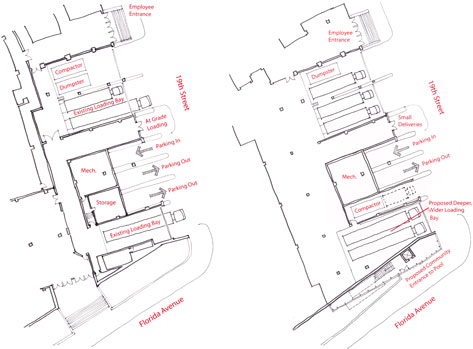On Hilton, HPO takes broad view of historic compatibility
The Historic Preservation Office is recommending that HPRB wait to approve the Hilton’s proposed renovations until the hotel can work out an agreement with the community over loading docks. Once that is done, the staff report recommends moving ahead with the project.
Loading is a severe problem along 19th Street. When the Hilton was first constructed, planners anticipated a freeway running along Florida Avenue west of Connecticut and then eastward between T and U. The Hilton was to sit at the edge of the freeway, and 19th Street would have been primarily an access road on and off the freeway.
Instead, thankfully, 19th stayed a neighborhood residential street, but instead of sitting under a freeway, the loading docks now impact the neighborhood. The bays are not deep enough for many of today’s trucks, which stick out across the sidewalk, blocking pedestrian traffic and creating noise.

Neighbors and the ANCs of Adams Morgan and Dupont Circle have consistently brought up this issue, often to deaf ears. At the landmark hearing in July, HPRB Chairman Tersh Boasberg repeatedly cut off witnesses who mentioned the loading problems, claiming they had no place in the landmark decision. But, at least according to the staff report, they are appropriate to discuss when reviewing the proposed modifications.
One of historic preservation’s controversies revolves around how broadly preservationists should evaluate each project. Is their mandate simply to consider the aesthetic appearance of the building in the context of a historic area, or can they address other concerns? How do we define what factors go into determining if a change is ‘compatible’?
ANCs such as Dupont’s have regularly clashed with HPRB over this very issue. For the building at 1433 T Street, the allegations of tenant abuse fell outside HPRB’s mandate to approve or disapprove the proposed alterations on historic grounds. When rejecting the raze permit for Third Church, HPRB Chairman Tersh Boasberg repeatedly stressed that the Board could not consider the religious liberty arguments made by church officials.
The impact of loading docks, however, represent a grayer area. One could argue that loading and traffic impacts a historic district in more direct ways than tenant abuse or religious liberty, and therefore that it’s appropriate for HPRB to insist on a satisfactory solution to the problem as part of a historic review.
The report, primarily written by Historic Preservation Office director David Maloney, states,
From its initial discussions with the applicants, the staff has stressed both the importance of achieving compatibility with the historic landmark and the need to address long-standing community concerns about the impact of the hotel design and operations on its neighbors. Some of these concerns relate more to urban planning than historic preservation issues, but in the context of a multi-year project representing the most substantial change to the building since its completion, a thorough consultation on these issues with all interested parties has seemed the only appropriate course of action.
What to do about the loading docks? Neighbors have asked the Hilton to move the loading docks into the garage, creating a passageway where they would enter on T Street and exit on 19th Street. According to the staff report, the owners’ analysis shows this to be cost prohibitive. Instead, the Hilton has proposed reducing the two lanes of traffic exiting the garage to one lane, making room for wider and deeper loading bays. The trash compactor would also go in a deeper bay with room for a truck to completely park in front without sticking out.
Neighbors have panned the Hilton’s loading dock suggestions, arguing they don’t do enough to alleviate the issues. 19th Street is narrow, and trucks often have to back up several times to get into the spaces. Since the Hilton stands to make a great deal of money, they argue, they should do more to fix this problem rather than push negative impacts of the expansion onto the surrounding streets.
Tomorrow: The rest of the Hilton’s plan, including the urbanism issues along the Connecticut Avenue, T Street, and Florida Avenue faces.


